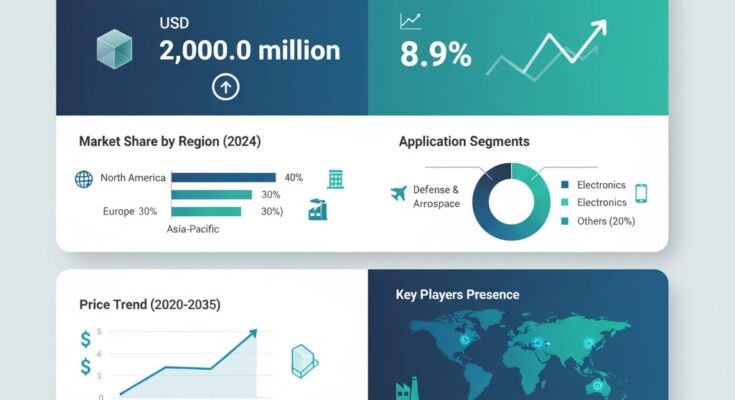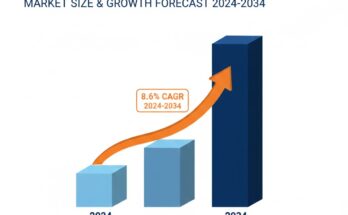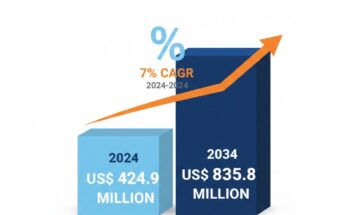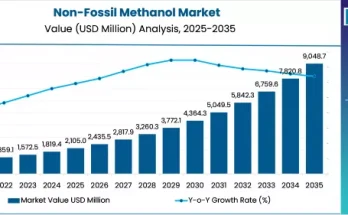The global transparent aluminum market is poised for remarkable expansion as technological advances and rising demand across aerospace, defense, and optical applications accelerate adoption. According to a recent study by Fact.MR, the market is projected to grow from USD 850.0 million in 2025 to approximately USD 2,000.0 million by 2035, recording an absolute increase of USD 1,150.0 million over the forecast period. This represents a total growth of 135.3%, with the market expected to expand at a CAGR of 8.9% between 2025 and 2035.
Transparent aluminum, scientifically known as aluminum oxynitride (ALON), is rapidly emerging as a superior alternative to traditional glass and ceramics due to its exceptional strength, optical clarity, and resistance to environmental and mechanical stress. Its adoption is surging in critical sectors including military armor, spacecraft windows, optical domes, and sensor systems, where durability and transparency are equally essential.
Market Drivers: Advanced Materials, Security Applications, and Aerospace Expansion
Defense and Military Armor Applications
Transparent aluminum has gained immense traction in defense applications, particularly for bullet-resistant windows, sensor covers, and vehicle armor. Its ability to withstand high-velocity impacts while maintaining optical visibility has made it an ideal material for next-generation military vehicles and protective enclosures. Increasing investments in lightweight armor technologies by global defense agencies are further boosting demand.
Aerospace and Space Exploration Demand
The aerospace industry is one of the largest consumers of transparent aluminum due to its superior strength-to-weight ratio and ability to endure extreme thermal conditions. It is being increasingly adopted in aircraft canopies, cockpit shields, and spacecraft windows. With major space programs expanding in the U.S., China, and Europe, the use of ALON for satellite and spacecraft components is projected to rise sharply.
Optical and Electronics Integration
Transparent aluminum is transforming optical systems, such as infrared lenses, sensors, and surveillance domes, offering high transparency across visible and infrared wavelengths. Its role in consumer electronics is also growing, with potential applications in smartphone screens, wearables, and optical sensors that demand both clarity and durability.
Technological Advancements: From Lab to Large-Scale Production
Manufacturers are scaling up production capabilities to make transparent aluminum more cost-effective and widely available. Recent progress in powder processing, sintering technologies, and nanomaterial integration has improved optical clarity, reduced production defects, and enhanced impact resistance. Partnerships between defense contractors and material manufacturers are accelerating commercial viability for both military and industrial applications.
Shift Toward Sustainable and Long-Lasting Materials
As industries pursue materials that reduce lifecycle costs and environmental impact, transparent aluminum stands out for its longevity, recyclability, and reduced maintenance requirements. Its extended service life and ability to replace multilayered glass laminates make it an eco-efficient choice in modern engineering and construction.
Competitive Landscape
The transparent aluminum market is characterized by strong R&D collaboration, high capital investment, and strategic partnerships among leading manufacturers. Companies are focusing on expanding production capacity, improving optical performance, and entering emerging markets.
Key Players in the Transparent Aluminum Market:
- Surmet Corporation
- Raytheon Technologies Corporation
- CoorsTek Inc.
- Saint-Gobain S.A.
- Kyocera Corporation
- AGC Inc.
- SCHOTT AG
- CeraNova Corporation
- 3M Company
- II-VI Incorporated
- TeraView Ltd.
- Arconic Corporation
- Safran Group
- Lockheed Martin Corporation
- Transparent Armor Systems LLC
These key players are investing in commercial-scale ALON production, expanding applications in aerospace and defense, and partnering with government agencies for next-generation material solutions.
Recent Developments
- June 2025 – Surmet Corporation unveiled a new large-scale transparent aluminum armor panel capable of resisting multiple ballistic impacts while maintaining visual clarity, designed for military vehicles and aircraft.
- January 2025 – Raytheon Technologies announced a strategic collaboration to integrate transparent aluminum sensor domes into next-generation missile defense systems, enhancing durability and precision tracking.
- October 2024 – Kyocera Corporation introduced transparent ceramic-based ALON composites optimized for high-temperature optics and advanced imaging systems.
Regional Outlook
North America – Global Leader in Production and Defense Applications
The U.S. dominates due to the presence of key defense manufacturers and extensive government funding for transparent armor technologies. Surmet and Raytheon Technologies are at the forefront of innovation in the region.
Europe – Expanding Aerospace and Optics Integration
Countries like Germany, France, and the U.K. are investing in aerospace-grade transparent ceramics, driving material demand through industrial modernization and space exploration initiatives.
Asia-Pacific – Emerging Production Hub
China, Japan, and South Korea are investing in domestic production facilities and research collaborations to expand transparent aluminum use in electronics and optics. The region is expected to record the fastest growth over the forecast period.
Future Outlook: Toward Ultra-Resilient Transparent Materials
The next decade will mark a significant leap in transparent material technologies, with the transparent aluminum market evolving toward:
- Scalable Manufacturing – Lower production costs through advanced sintering and additive techniques.
- Enhanced Optical Performance – Improved transparency across wider spectral ranges.
- Integration with Smart Systems – Use in sensors, autonomous vehicles, and defense monitoring systems.
- Sustainability and Recycling – Emphasis on eco-friendly and long-life materials.
By 2035, transparent aluminum is expected to play a pivotal role in shaping next-generation defense, aerospace, and optical technologies, offering an unmatched balance of strength, transparency, and endurance.



